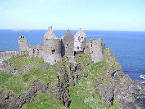DUNLUCE CASTLE (2) was built in 1904 by Harland & Wolff at Belfast with a tonnage of 8114 grt, a length of 475ft 5in, a beam of 56ft 8in and a service speed of 14 knots.
Sister of the Dover Castle she was built for the Intermediate service and in January 1910 undertook the first London-Cape-Delgoa Bay- Mombasa sailing.
In August 1914 she became a troopship and took part in the famous six ship Union-Castle convoy which brought 4000 troops to Europe.
She was commissioned as a hospital ship for 755 patients on 6th July 1915 and at Gallipoli and Mudros acted as transfer ship to White Star's Britannic before going to East Africa for duty with the Indian Government.
In 1916 she was back in the Mediterranean for service which included voyages from the Adriatic to North Africa with wounded Serbs.
On 23rd February 1917 she was stopped by a U-boat and after checking that she was complying with the Hague Convention was allowed to proceed.
She returned to commercial service on 2nd April 1919 and resumed her original run until 1931 when she was transferred to the Round Africa service.
In July 1939 she was sold for breaking up but acquired by the Admiralty for use as an accommodation ship for small vessels first in the River Humber and then at Scapa Flow. She became HMS Dunluce Castle
1940 Purchased by The Admiralty
She was finally broken up by Thos.W. Ward at Inverkeithing in 1945.
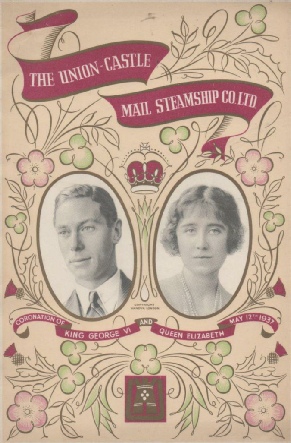
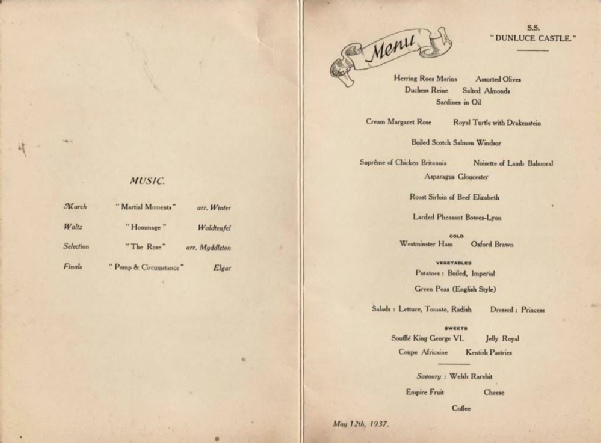
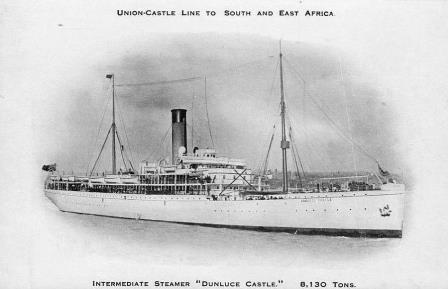
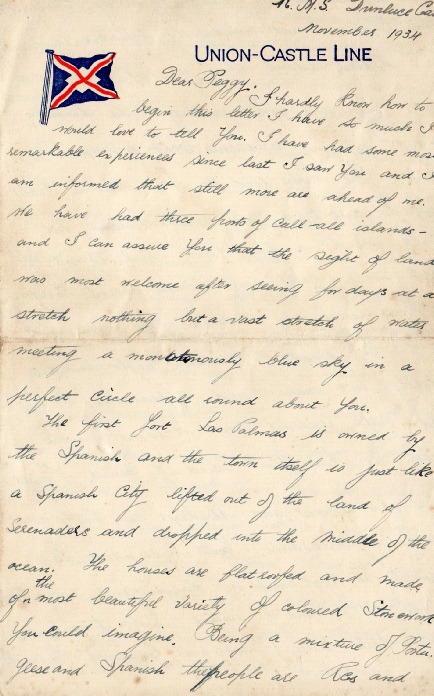
R.M.S. Dunluce Castle
November 1934
Dear Peggy,
I hardly know how to begin this letter I have so much I would love to tell you.
I have had some most remarkable experiences since last I saw you and I am informed still more are ahead of me.
We have had three ports of call - all islands- and I can assure you that the sight of land was most welcome after seeing for days at a stretch nothing but a vast stretch of water meeting a monotonously blue sky in a perfect circle all round about you.
The first port Las Palmas is owned by the Spanish and the town itself is just like a Spanish City lifted out of the land of Serenaders and dropped into the middle of the ocean.
The houses are flat roofed and of the most beautiful variety of coloured stonework you could imagine.
Being a mixture of Portugese and Spanish the people all (Res) and
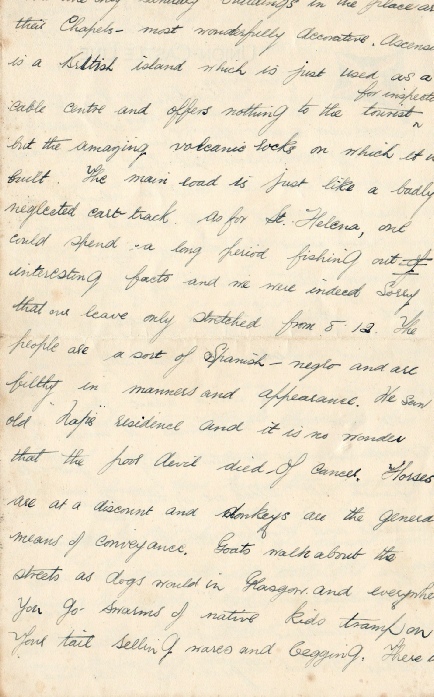
about the only sanitary buildings in the place are their Chapels - most wonderfully decorative.
Ascension is a British island which is just used as a cable centre and offers nothing to the tourist but amazing volcanic rocks on which it is built. The main road is just like a badly neglected cart track.
As for St Helena one could spend a long period fishing out interesting facts and we were indeed sorry that our leave only stretched from 8 - 12.
The people are a sort of Spanish negro and are filthy in manners and appearance.
We saw old “Napes” residence and it is no wonder that the poor devil died of cancer. Horses are at a discount and donkeys are the general means of conveyance.
Goats walk about the streets as dogs would in Glasgow and everywhere you go swarms of native kids tramp on your tail selling wares and begging. There is
a flight of stairs - 400 in all - or equivalent to 30 storys of a Glasgow tenement building; called locally “Jacobs Ladder” and of course we weren’t satisfied till we were at the top although the ladies(particularly those of your build) found it very strenuous.
We were all glad to get the opportunity of stretching our limbs and the following morning we had some good fun watching the older folks getting into their bunks and struggling up and down the companions.
Well so much for the escapades ashore Peggy. I could go on for ever but I am scared I bore you.
I dropped a PC to you from the island Peg but I am afraid it wouldn’t get you as I made a blind guess at your number in “R St” as my address book was left behind me on board.
The days have slipped on annoyingly fast
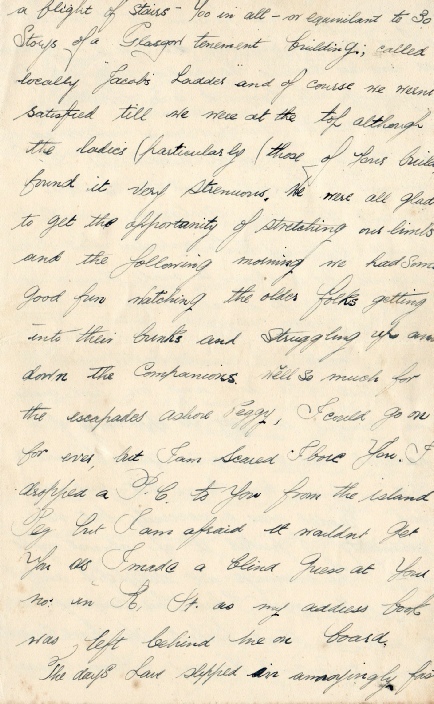
and it doesn’t seem like only 4 weeks since that Friday evening I said au revoir to the sweetest creature that ever came into the life of a confirmed soul-less bachelor.
We have a very long day beginning with hymns at 6.30 taken by a sergeant in the Marines and followed by a dip in our “glorified horse-trough”.
The morning is generally spent on the deck playing the various deck games or in the lounge listening to the orchestra. The ship’s engines get a chance to make themselves heard from 2 - 4 as almost all the women and kids spend this period in bed having a siesta.
The sun is rather warm at this part of the day and we poor males are thankful to get the opportunity of a peaceful read or a quiet game of cards.
Tell our friend Miss Harvie that just as she said, Bridge was a necessity but very fortunately I picked it up right away. The evenings are delightful and I many a time wish I had your company just to make the thing perfect. We have Concerts, Community Singing, a Fancy Dress
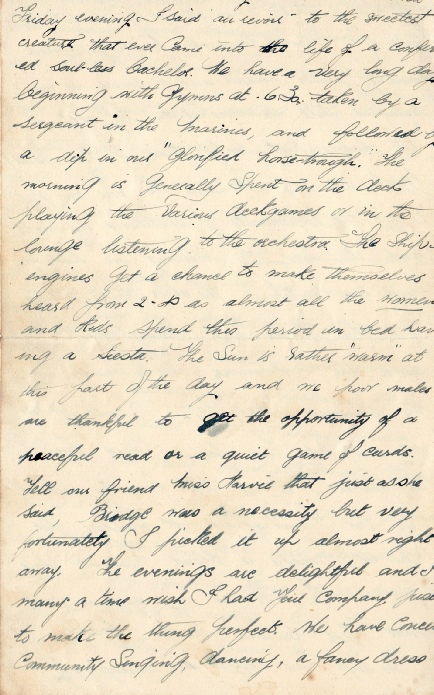
ball, novelty numbers such as, a derby, dog racing, treasure hunt, book dinners all of which would too long to explain.
In London I had the most marvelous time and without the aid of anyone I was able to find my way about.
I was very much impressed with all I saw and I am quite looking forward to spending a week or so there on my first visit home which you can bet will be very soon.
I have met some good friends on board and the number of Scots people bound for Transvaal would surprise you.
We are all one big happy family and I am eagerly looking forward to joining the Caledonian Society when I settle down.
At the station the night I left Auld Scotia behind me I was introduced to a young married woman bound for Joburg too, to join her husband and her people asked me to be her companion during the voyage and I readily consented more because of the
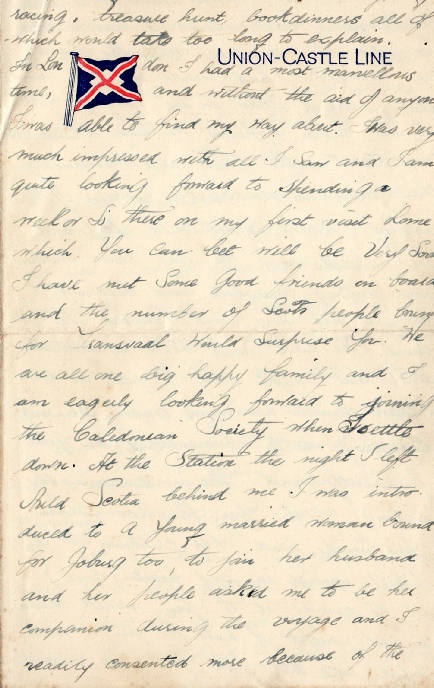

Pity I had for her condition than for a desire for company as lonely as I was, I had no notion of mixing with the passengers socially. I had made up my mind that I would study on the voyage but its all been hopeless.
We had a reserved compartment on the train and because of the terrible indescribable strain of the parting neither of us could sleep and we whiled away the long journey chatting and eating chocolate and biscuits. I got all her story and of course she got mine.
We have never been separated since that night and I feel as if I had known her much longer. During our many talks I mentioned you quite frequently and she is continually joking about you.
She has seen your snap and her criticism of you I will nurse in my heart (brick) as to convey it to you would mean a new outfit of hats for you - and I did like that hat you wore on one
particular Sunday. However she doesn’t understand how you weren’t at the station as did likewise many of my friends but I put up with your excuse and it was accepted.
What about a snap Peg, old girl, of you in your Rangers uniform. If it was convenient, I know my “big sister” would be interested, but of course old Sol isn’t “at home” during the month of November!
Which reminds me that the first female set eyes on St Helena was little black girl in guides uniform selling poppies for Earl Haig’s fund.
I had to smile and I am sorry that I didn’t get an opportunity of snapping her.
Well Peg, old horse, I am quite looking forward to a reply from you but its a long while to wait but my mind will be more composed the next time I write your name.
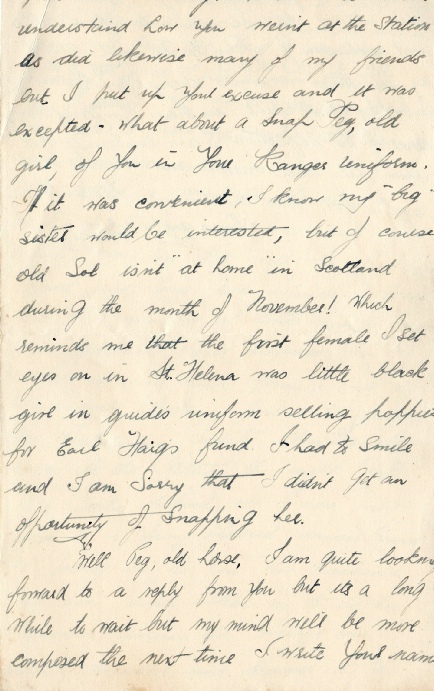
I would like you to give my regards to Josie, Mary, Maude and to your folks not excluding John Davie and Mary as all their names conjure up memories of happy days spent in their company.
Keep some of the affection I am enclosing for you for your meter and thanks once again for your charming presents.
Yours aye
Jack



In August 1914 she became a troopship and took part in the famous six ship Union-Castle convoy which brought 4000 troops to Europe.
In August 1914 she became a troopship and took part in the famous six ship Union-Castle convoy which brought 4000 troops to Europe. She was commissioned as a hospital ship for 755 patients on 6th July 1915 and at Gallipoli and Mudros acted as transfer ship to White Star's Britannic before going to East Africa for duty with the Indian Government. In 1916 she was back in the Mediterranean for service which included voyages from the Adriatic to North Africa with wounded Serbs. On 23rd February 1917 she was stopped by a U-boat and after checking that she was complying with the Hague Convention was allowed to proceed
Service in WW1
Memories of a Voyage - 1934
Coronation of King George VI - 12 May 1937
Master |
From
|
To
|
|
J L Stanistreet
|
10/1904
|
5/1906
|
|
J W Hague
|
5/1906
|
2/1913
|
|
H M Cruise
|
4/1909
|
7/1909
|
|
N R Neilson
|
2/1913
|
|
|
M D Butterwick
|
2/1913
|
12/1917
|
|
N R Neilson
|
7/1913
|
8/1913
|
|
B A Bryan
|
4/1914
|
|
|
M D Butterwick
|
6/1918
|
|
|
H B Piers
|
6/1920
|
|
|
W F Stanley
|
9/1920
|
5/1921
|
|
M D Butterwick
|
6/1921
|
4/1922
|
|
A S Knight
|
8/1922
|
1/1923
|
|
S H Owen
|
1/1923
|
7/1924
|
|
C R Jackson
|
4/1923
|
5/1923
|
|
G Owens
|
7/1924
|
4/1926
|
|
H Basden-Smith
|
10/1924
|
|
|
W Morton Betts
|
8/1926
|
11/1926
|
|
J H Kerbey
|
7/1927
|
11/1927
|
|
C R Jackson
|
11/1927
|
5/1928
|
|
E F Gilbert
|
2/1928
|
3/1928
|
|
A O Morgan
|
6/1928
|
12/1928
|
|
C R Jackson
|
2/1929
|
12/1929
|
|
A O Morgan
|
1/1930
|
4/1930
|
|
A Hutchings
|
4/1930
|
4/1932
|
|
C E Aylen
|
7/1931
|
|
|
|
5/1932
|
|
|
J McMahon
|
5/1932
|
8/1932
|
|
W Weller
|
9/1932
|
2/1933
|
|
A H Blackman
|
3/1933
|
8/1933
|
|
D Nicoll
|
9/1933
|
6/1934
|
|
C E Aylen
|
7/1934
|
10/1935
|
|
W S Colbourne
|
11/1935
|
8/1936
|
|
S F Newdigate
|
8/1936
|
11/1936
|
|
E H Thornton
|
12/1936
|
6/1937
|
|
H L Leepman Shaw
|
6/1937
|
9/1937
|
|
H E Jackson
|
10/1937
|
11/1938
|
|
A Alderson
|
6/1939
|
7/1939
|
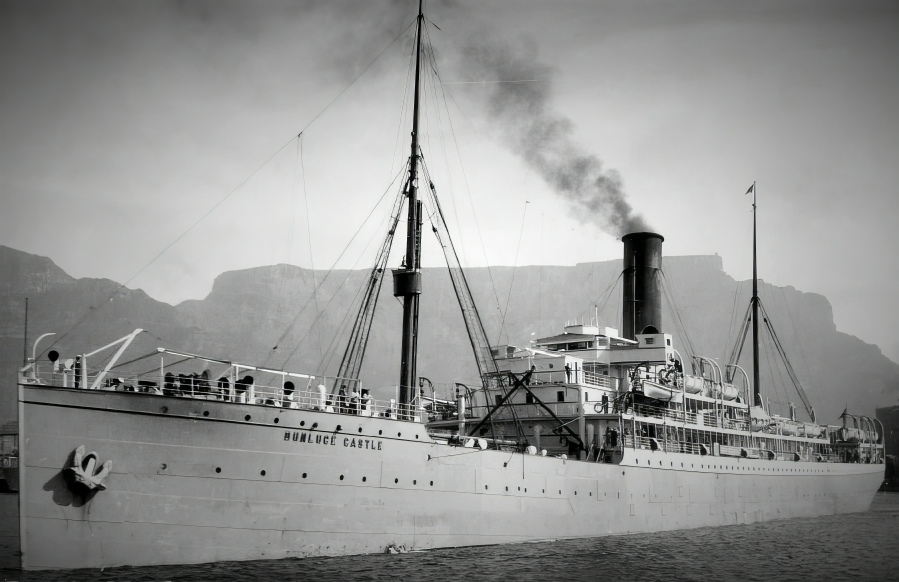
|
Vessel
|
Built
|
Tonnage
|
Official No
|
Ship Builder
|
Engine Builder
|
Engine Type
|
HP
|
Screws
|
Speed
|
|
Dunluce Castle (2)
|
1904
|
8114
|
118490
|
Harland & Wolff
Belfast
|
2 x Quadruple Expansion Steam
|
5200 IHP
|
2
|
14
|
Career Summary
